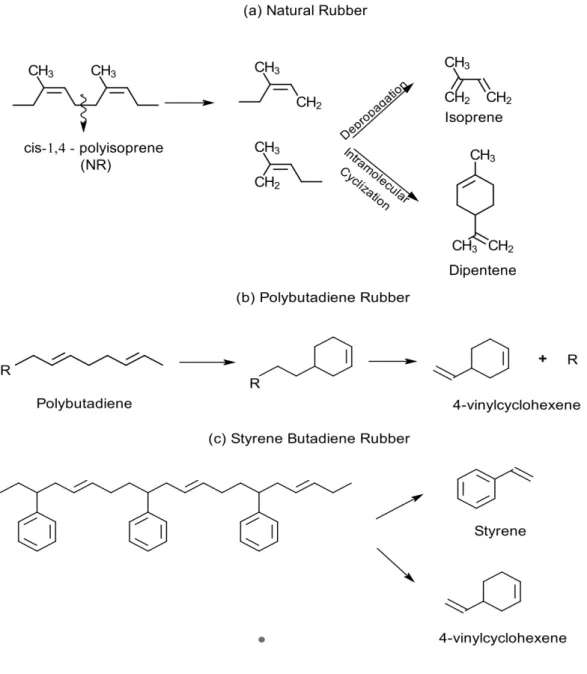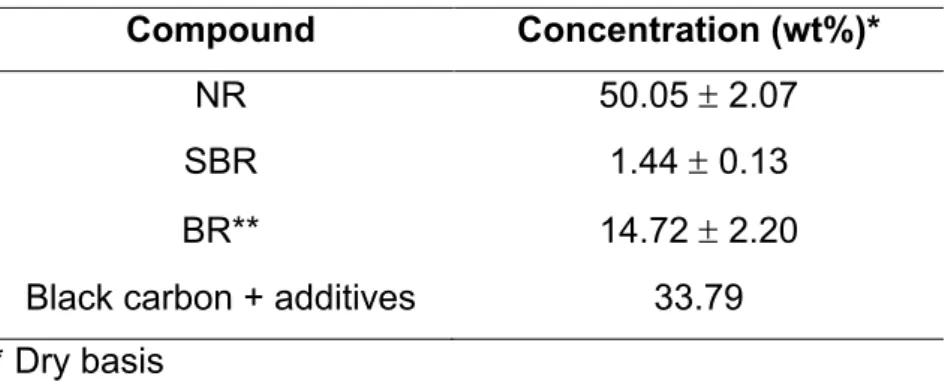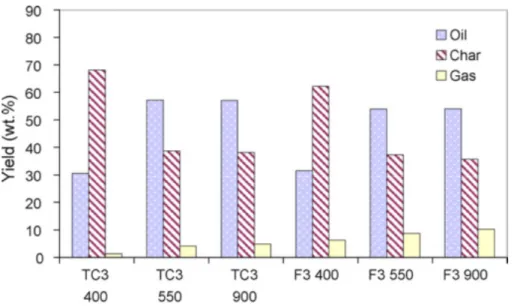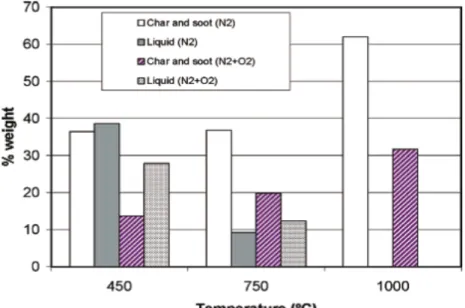Pépite | Étude expérimentale de la production d'aromatiques par la pyrolyse des pneus de caoutchouc en utilisant des catalyseurs à base d'hétéropolyacides
Texte intégral
(2) Thèse de Claudia Patricia Tavera Ruiz, Lille 1, 2017. EXPERIMENTAL STUDY OF THE AROMATICS PRODUCTION FROM THE PYROLYSIS OF SCRAP TIRES RUBBER USING HETEROPOLYACIDS- BASED CATALYSTS Doctoral thesis presented to: Universidad Industrial de Santander and L’Université de Lille 1 Sciences et Technologies As a requirement to obtain the double degree: Doctor in Chemical Engineering and Doctor in Chemistry - Specialty: Science of matter, radiation and the environment By CLAUDIA PATRICIA TAVERA RUIZ Dissertation on October 13 of 2017 in Bucaramanga Colombia, in front of the examination committee: Jury Dr. Fernando Viejo Abrante –Universidad Industrial de Santander Dr. Julio Andrés Pedraza Avellaneda-Universidad Industrial de Santander Dra. Dorothée Laurenti – IRCELYON Université Lyon 1 Dr. Pascal Fongarland – Université Claude Bernard Lyon 1 Dr. Pascal Roussel – Université de Lille 1 Sciences and Technologies. Thesis Directors: PhD. Maria Paola Gauthier Maradei - Universidad Industrial de Santander PhD. Mickael Capron - Université de Lille 1 Sciences et Technologies. . © 2017 Tous droits réservés.. lilliad.univ-lille.fr.
(3) Thèse de Claudia Patricia Tavera Ruiz, Lille 1, 2017. ACKNOWLEDGMENTS I would like to express my gratitude and appreciation to each person and entities who supported me during the 5 years of my PhD, with which successful completion would not have been possible: To my director Dr. Maria Paola Maradei, for the trust placed in me, the opportunity offered with the topic of thesis, her support, guidance and inspiration, and for each teaching given at a professional and personal level. To my director Mickael Capron, for the opportunity given with the cotutele, for all his support, learning, good reception and patience during my stay in France. To Colciencias for the financial support with the scholarship of the call 567, and to Colfuturo who administered fully and properly the resources during the 5 years. To the Vicerrectoría de Investigación y Extensión from Universidad Industrial de Santander for the financial support through the project No. 1843 and the program of doctoral support project No. 1858. To my research group INTERFASE, for the availability of its facilities and equipment, the collaboration, support, friendship and good moments during these 5 years. To the Chemical Engineering School of the Universidad Industrial de Santander for the financial support for the completion of my internship and for the facilitation of the equipment and the analysis services provided. To my sons, my students: Diego Villamizar, Yenny Sanchez, Luis Enrique Bohórquez, Catalina Carmargo, Diana Parra, Alejandro Lemus, Deyanira Ferreira, Cristian Palencia and Iván Luna, for their hard work and their extensive collaboration during the experimental tests. . © 2017 Tous droits réservés.. 3 lilliad.univ-lille.fr.
(4) Thèse de Claudia Patricia Tavera Ruiz, Lille 1, 2017. To UCCS and its staff for the reception, financing, training and services provided in the performance of analysis. I want to especially thank to Cyril Pirez, Benjamin Katryniok, Olivier Gardoll and Jean Charles Morin, for all their help, guidance and collaboration. To the jury: Dr. Fernando Viejo Abrante, Dr. Julio Andrés Pedraza, Dra. Dorothée Laurenti, Dr. Pascal Fongarland and Dr. Pascal Roussel for accepting the role of examiners and evaluators of my thesis. To my family, my inspiration, they are all in my life, thanks for believing in me and always support me. To my friends Sebastián, Mónica, Liliana, Lilou, Said and Jesús for their support and always listen to me in difficult and sad moments of my thesis. And finally, to each of those people who were in my life and heart during these 5 years, each one left something special and great teachings in me. . © 2017 Tous droits réservés.. 4 lilliad.univ-lille.fr.
(5) Thèse de Claudia Patricia Tavera Ruiz, Lille 1, 2017. TABLE OF CONTENTS ABSTRACT ....................................................................................................... 19 RÉSUMÉ ........................................................................................................... 20 RESUMEN ......................................................................................................... 21 Chapter 1 Generalities .................................................................................... 22 1.1. GENERAL INTRODUCTION ............................................................ 22 1.2. THEORETICAL FRAMEWORK ........................................................ 26 1.2.1Pyrolysis Process .............................................................................. 26 1.2.2Heteropolyacids. ............................................................................... 30 1.2.3 Mesoporous materials ..................................................................... .35 1.3. REFERENCES OF THIS CHAPTER ............................................... 39 1.4. BIBLIOGRAPHY OF THIS CHAPTER ............................................. 47 Chapter 2 Characterization of raw material .......................................... 55 2.1 INTRODUCTION .............................................................................. 55 2.2 METHODOLOGY ............................................................................. 57 2.2.1 Elemental and Proximate analysis ................................................... 57 2.2.2 Real and Bulk densities ................................................................... 57 2.2.3 Quantification of the polymer compounds ........................................ 57 2.3 RESULTS AND DISCUSSION ......................................................... 60 2.4 CONCLUSIONS ............................................................................... 65 2.5 REFERENCES OF THIS CHAPTER .............................................. 66 2.6 BIBLIOGRAPHY OF THIS CHAPTER ............................................. 69 Chapter 3 Experimental study of the pyrolytic oil and aromatic compounds production from pyrolysis of scrap tires rubber ............ 72 3.1 INTRODUCTION .............................................................................. 72 3.2 STATE OF THE ART ....................................................................... 75 3.3 DESCRIPTION OF THE PILOT UNIT .............................................. 82 3.4 METHODOLOGY ............................................................................. 85 3.4.1 Preliminary tests……………………………………………….. ........... 85 3.4.2 Study of the temperature and nitrogen flow influence on pyrolytic oil yield and aromatic concentration .............................................................. 85 3.4.3 Study of the gas residence time influence on the pyrolytic oil and aromatic compounds production. ............................................................. 87 3.4.4 Experimental study of the reaction time influence on the aromatic compounds production. ............................................................................. 89 3.4.5 Characterization of pyrolytic oil ........................................................ 89 3.5 RESULTS AND DISCUSSION ......................................................... 90 3.5.1 Experimental study of the temperature and nitrogen volumetric flow influence on pyrolytic oil yield.. ................................................................. 90 . © 2017 Tous droits réservés.. 5 lilliad.univ-lille.fr.
(6) Thèse de Claudia Patricia Tavera Ruiz, Lille 1, 2017. 3.5.2 Characterization of pyrolytic oil.. ...................................................... 97 3.5.3 Experimental study of the temperature and nitrogen volumetric flow influence on aromatic yield. .................................................................... 102 3.5.4 Experimental study of the gas residence time influence on pyrolytic oil yield and aromatic concentration. ........................................................... 106 3.5.5. Experimental study of the reaction time influence on aromatic concentration. ......................................................................................... 113 3.6 CONCLUSIONS ............................................................................. 116 3.7 REFERENCES OF THIS CHAPTER ............................................ 117 3.8 BIBLIOGRAPHY OF THIS CHAPTER .......................................... 127 Chapter 4 Catalysts synthesis and characterization ......................... 137 4.1. INTRODUCTION ............................................................................ 137 4.2 STATE OF THE ART ..................................................................... 140 4.3 METHODOLOGY ........................................................................... 146 4.3.1 Catalysts series 1: Synthesis and characterization: Four active phases supported on a commercial support. ....................................................... 146 4.3.2 Catalysts series 2: Synthesis and characterization: One active phase supported on three supports. .................................................................. 149 4.4 RESULTS AND DISCUSSION ....................................................... 152 4.4.1 Catalysts Series 1 characterization ................................................ 152 4.4.1.1 Verification of the purity of synthesized HPMoV. ...................... 152 4.4.1.2 Textural Characteristics. ........................................................... 153 4.4.1.3 Verification of the active phase on the support after impregnation and calcination ...................................................................................... 155 4.4.1.4 Acidity characteristics. .............................................................. 157 4.4.2 Catalysts series 2 characterization ................................................ 159 4.4.2.1 Synthesized supports characterization ..................................... 159 4.4.2.2 Catalysts supported characterization ....................................... 163 4.4.2.3 Acidity characteristics ............................................................... 166 4.5 CONCLUSIONS ............................................................................. 168 4.6 REFERENCES OF THIS CHAPTER ............................................. 169 4.7 BIBLIOGRAPHY OF THIS CHAPTER ........................................... 176 Chapter 5 Study of the transformation of D,L limonene into simple aromatic compounds ............................................................................ 183 5.1 INTRODUCTION ............................................................................ 183 5.2 STATE OF THE ART ..................................................................... 186 5.3 METHODOLOGY ........................................................................... 195 5.4 RESULTS ....................................................................................... 198 5.4.1 Catalytic tests on pyroprobe coupled to GC-FID ........................... 198 5.4.1.1 Preliminary tests for determination of kinetic regime ................ 198 5.4.1.2 Test Type 1: Influence of temperature on the conversion of D, L limonene and the yield of products ....................................................... 199 5.4.1.3 Test Type 2: Influence of the active phase on the conversion, yield and selectivity toward aromatics. .......................................................... 206 . © 2017 Tous droits réservés.. 6 lilliad.univ-lille.fr.
(7) Thèse de Claudia Patricia Tavera Ruiz, Lille 1, 2017. 5.4.1.4 Test Type 3: Influence of the support on the conversion, yield and selectivity toward aromatics. ................................................................. 214 5.5 CONCLUSIONS ............................................................................. 217 5.6 REFERENCES OF THIS CHAPTER ............................................. 218 Chapter 6 Experimental validation of the catalysts in the pilot pyrolysis unit ......................................................................................................... 236 6.1 INTRODUCTION ............................................................................ 236 6.2 STATE OF THE ART ..................................................................... 237 6.3 METHODOLOGY ........................................................................... 248 6.3.1. Catalytic tests on laboratory-scale reactor using D, L limonene as raw material.. ................................................................................................. 248 6.3.2 Catalytic tests on laboratory-scale reactor using STR as raw material ………………………………………………………………………………..253 6.4 RESULTS ....................................................................................... 255 6.4.1. Catalytic tests on laboratory-scale reactor using D, L limonene as raw material. .................................................................................................. 255 6.4.1.1 Study of the influence of the active phase on the conversion and production of p-cymene ........................................................................ 255 6.4.1.2 Study of the influence of support on the aromatic production. . 257 6.4.1.3 Influence of the temperature on the conversion and production of p-cymene.. ............................................................................................ 259 6.4.1.4 Identification and quantification of the carbonaceous material deposited on the catalyst surface.. ....................................................... 262 6.4.2 Catalytic tests on laboratory-scale reactor using STR as raw material………………………………………………………………………...263 6.5 CONCLUSIONS ............................................................................. 271 6.6 REFERENCES OF THIS CHAPTER ............................................. 272 6.7 BIBLIOGRAPHY OF THIS CHAPTER .......................................... 276 General Conclusions ................................................................................. 280 Publications ................................................................................................ 283 Communications ........................................................................................ 284 Annexes ...................................................................................................... 285 . © 2017 Tous droits réservés.. 7 lilliad.univ-lille.fr.
(8) Thèse de Claudia Patricia Tavera Ruiz, Lille 1, 2017. LIST OF FIGURES Figure 1. Several types of reactors used in pyrolysis process: (a) Stirred tank – (b) Fluidized bed reactor – (c) Fixed bed reactor – (d) Auge reactor – (e) CSBR – (f) Rotatory Kiln. .......................................................................................................... 29 Figure 2. Distribution of product lumps (wt%) for different types of reactors, taken from Hita et al. [29]. ................................................................................................ 30 Figure 3. Keggin Structure from database code ICSD 31897. ............................... 32 Figure 4. Structure of MCM-41 and other M41S family taken from Grecco et al. [59]. ................................................................................................................................ 37 Figure 5. SBA-15 Structure taken from Yue et al. and Database of Material Center of Technische Universitat Dresden [60,61]. ........................................................... 37 Figure 6. KIT-6 Structure taken from Ye et al. [62]. ............................................... 38 Figure 7. Methodology for quantification of polymers in the tire using Py-GC/FID. 58 Figure 8. Unit Pyroprobe coupled to a GC/FID chromatograph. ............................ 59 Figure 9. Main monomers produced by pyrolysis for each polymer present in the STR sample: (a) NR, (b) BR and (c) SBR. ............................................................. 63 Figure 10. Yields of pyrolysis products at different temperatures by Fernandez et al. [40]. ........................................................................................................................ 77 Figure 11. Yield of the different fractions as a function of temperature by Conesa et al. [43]. .................................................................................................................... 78 . © 2017 Tous droits réservés.. 8 . lilliad.univ-lille.fr.
(9) Thèse de Claudia Patricia Tavera Ruiz, Lille 1, 2017. Figure 12. The pilot pyrolysis unit used for the experimental test. ......................... 83 Figure 13. Loading scheme to fill the reactor ......................................................... 84 Figure 14. Yields at different conditions of temperatures and nitrogen volumetric flow: (a) Pyrolytic oil yield, (b) Char yield and (c) Gas yield. ........................................... 91 Figure 15. Contour plot of the effect of temperature and nitrogen volumetric flow on the pyrolytic oil yield. .............................................................................................. 96 Figure 16. The density of pyrolytic oil measured at each operating conditions of the experimental plan. .................................................................................................. 98 Figure 17. Acidity of pyrolytic oil as function of temperature and volumetric gas flow. ................................................................................................................................ 98 Figure 18. HHV obtained at different operating conditions. .................................... 99 Figure 19. Concentration of aromatics compounds and limonene on pyrolytic oil at each operating condition. ..................................................................................... 100 Figure 20. Polyisoprene (cis-1,4-polyisoprene) transformation to isoprene and limonene by two competitive reactions. ................................................................ 102 Figure 21. Aromatics and limonene yields at each operating condition. .............. 103 Figure 22. Effect of temperature and nitrogen volumetric flow on aromatics yield: (a) Response surface - (b) Contour plot. ................................................................... 105 Figure 23. Pyrolytic oil and gas yield at all residence times and at: (a) 466 °C and (b) 600 °C. ................................................................................................................. 107 Figure 24. Aromatics and limonene concentration at 466 ºC function of the gas residence times. ................................................................................................... 109 . . © 2017 Tous droits réservés.. 9 . lilliad.univ-lille.fr.
(10) Thèse de Claudia Patricia Tavera Ruiz, Lille 1, 2017. Figure 25. Concentrations of BTX aromatic compounds at 466 ° C and different residence times: (a) toluene, (b) benzene and (c) xylenes. ................................. 111 Figure 26. Yields of products of STR pyrolysis at different reaction times, and at constant temperature and nitrogen flow (466 ºC and 155 Nml/min). .................... 113 Figure 27. Aromatics concentration at different reaction times, and constant temperature and nitrogen flow (466 ºC and 155 Nml/min). .................................. 114 Figure 28. HPMoV synthesis protocol .................................................................. 147 Figure 29. General procedure for the synthesis of mesoporous silica supports. . 150 Figure 30. X-Ray diffractogram of pure HPMoV synthetized. In red, the PDF-00- 052-1117 file corresponding to H3PMo12O40.13H2O. ............................................ 152 Figure 31. Raman spectrum of pure HPMoV synthetized. ................................... 153 Figure 32. N2 adsorption/desorption isotherms and the pore distribution for: (a) Support Q-10 without impregnation, (b) HPMo supported on Q-10, (c) HPMoV supported on Q-10, (d) HPW supported on Q-10, (e) HSiW supported on Q-10. 154 Figure 33. Raman Spectrum for each catalyst: (a) HPMo/Q-10, (b) HPMoV/Q-10 and (c) HPW/Q-10, (d) HSiW/Q-10. ............................................................................ 156 Figure 34. Total acidity function of temperature determined by NH3 TPD for catalysts with different active phase on commercial silica. ................................................. 157 Figure 35. Low-angle XRD patterns of the synthesized supports: (a) SBA-15, (b) MCM-41 and (c) KIT-6. ......................................................................................... 160 Figure 36. TEM Images of the synthesized supports: (a) SBA-15, (b) MCM-41 and (c) KIT-6. ............................................................................................................... 161 . . © 2017 Tous droits réservés.. 10 . lilliad.univ-lille.fr.
(11) Thèse de Claudia Patricia Tavera Ruiz, Lille 1, 2017. Figure 37. N2 adsorption/desorption isotherms for the supports: (a) Support Q-10 (commercial), (b) SBA-15, (c) MCM-41 and (d) KIT-6. ......................................... 162 Figure 38. Raman Spectrum for each catalyst: (a) HPMo/Q-10, (b) HPMoV/Q-10 and (c) HPW/Q-10, (d) HSiW/Q-10. ............................................................................ 165 Figure 39. Total acidity in function of temperature determined by NH3 TPD for catalysts with one active phase on different supports. ......................................... 166 Figure 40. p-cymene production from limonene. ................................................. 189 Figure 41. Limonene isomerization/aromatization mechanisms—I: limonene, II: terpinolene, III: a-terpinene, IV: g-terpinene, V: iso-terpinolene, VI: p-cymene, VII: 1- p-menthene and VIII: 3-p-menthene, proposed by Fernandes et al.[28]. ............. 191 Figure 42. Catalytic degradation mechanism of D, Limonene using HY, HZ and PA catalysts, proposed by Ding et al. [31]. ................................................................ 192 Figure 43. Reaction pathways followed upon transformation of limonene to p- cymene over titania catalysts proposed by Kamitsou et al. [27]. .......................... 194 Figure 44. Loaded protocole for quartz capillary of pyroprobe coupled to GC/FID. .............................................................................................................................. 196 Figure 45. Conversion of D, L limonene at different 𝐖𝐥𝐢𝐦𝐨𝐧𝐞𝐧𝐞 by keeping constant space-time. ........................................................................................................... 198 Figure 46. D, L limonene conversions obtained using catalyst HPMoV supported on SBA-15. ................................................................................................................ 199 Figure 47. Yield of products obtained by the transformation of D, L limonene using HPMoV supported on SBA-15. ............................................................................. 200 Figure 48. Possible path ways for the transformation of limonene into aromatic compounds reported in the literature. ................................................................... 202 . . © 2017 Tous droits réservés.. 11 . lilliad.univ-lille.fr.
(12) Thèse de Claudia Patricia Tavera Ruiz, Lille 1, 2017. Figure 49. Concentration of products obtained in greater proportion using HPMoV/SBA-15. ................................................................................................... 203 Figure 50. Conversion of D, L limonene obtained with different active phase on commercial silica Q-10 at 250 ºC. ........................................................................ 206 Figure 51. Selectivity toward the products obtained with different active phases on commercial silica Q-10 at 250 ºC. ........................................................................ 208 Figure 52. Mechanism proposed for limonene isomerization by hydrogen shift. . 211 Figure 53. Mechanism proposed in this study with the heteropolyacids-based catalysts. .............................................................................................................. 213 Figure 54. Conversion of HPMoV supported on Q-10, SBA-15, MCM-41 and KIT-6. .............................................................................................................................. 214 Figure 55. Selectivity of HPMoV supported on Q-10, SBA-15, MCM-41 and KIT-6 evaluated at 250 ºC. ............................................................................................. 215 Figure 56. Effect of catalyst bed temperature on yields of high value chemicals using CBV-400 as catalyst by Williams and Brindle [1]. ................................................ 239 Figure 57. Yield of pyrolysis products obtained from using the parent zeolites and 5%Fe-promoted catalysts by Muenpol et al. [10]. ................................................ 243 Figure 58. Effects of SBA-1 on the pyrolysis products: (A) product distribution, (B) liquid compositions by Dūng et al.[11] .................................................................. 244 Figure 59. Liquid composition obtained with catalyst 1%Ru/SBA-1 by Dūng et al. [11]. ...................................................................................................................... 245 Figure 60. Compositions of pyrolysis oils obtained from non-catalytic and catalytic pyrolysis obtained by Dūng et al. [12]. ................................................................. 246 . © 2017 Tous droits réservés.. 12 . lilliad.univ-lille.fr.
(13) Thèse de Claudia Patricia Tavera Ruiz, Lille 1, 2017. Figure 61. Molecular compounds in oils from using synthesized MCM-48 and Ru/MCM-48 catalysts by Witpathomwong et al. [13] ............................................ 247 Figure 62. Unit Pilot used to catalytic test of D, L limonene transformation. ........ 249 Figure 63. Loaded protocol in the laboratory-scale reactor. ................................. 250 Figure 64. Loading scheme to fill the reactor on: (a) pyrolysis, (b) pyrolysis with catalytic bed. ........................................................................................................ 253 Figure 65. Conversion of D, L limonene obtained using HPMo and HPMoV supported on commercial Q-10. ............................................................................................ 256 Figure 66. Selectivity towards p-cymene, monoterpenes and menthenes obtained from D, L limonene with HPMo/Q-10 and HPMoV/Q-10 catalysts at 250 ºC. ...... 257 Figure 67. Conversion of D, L limonene at 250 °C with HPMoV supported on Q-10 and SBA-15 supports. .......................................................................................... 258 Figure 68. Selectivity to p-cymene, monoterpenes and menthenes obtained with HPMoV supported in Q-10 and SBA-15 at 250 ° C. ............................................. 259 Figure 69. Influence of temperature on the conversion of DL-limonene using HPMoV supported in SBA-15. ........................................................................................... 260 Figure 70. Yield of p-cymene, monoterpenes and menthenes with HPMoV/SBA-15 catalyst at 250 ºC. ................................................................................................ 261 Figure 71. Selectivity towards p-cymene, monoterpenes and menthenes with HPMoV/SBA-15 catalyst at 250 ºC. ...................................................................... 262 Figure 72. Concentration of the aromatics and the partially saturated cyclic compounds in the pyrolytic oil produced by pyrolysis with and without catalytic stage. .............................................................................................................................. 266 . © 2017 Tous droits réservés.. 13 . lilliad.univ-lille.fr.
(14) Thèse de Claudia Patricia Tavera Ruiz, Lille 1, 2017. Figure 73. BTX aromatics production from two pathways: (1) Decomposition of dipentene - (2) Diels Alder reaction ..................................................................... 267 . © 2017 Tous droits réservés.. 14 . lilliad.univ-lille.fr.
(15) Thèse de Claudia Patricia Tavera Ruiz, Lille 1, 2017. LIST OF TABLES Table 1. Operating conditions for different types of pyrolysis according to the literature [40,46]. .................................................................................................... 28 Table 2. Structure and chemical formula for the main types of heteropolyacids taken from Viswanathan [47] and modified by the author. ............................................... 31 Table 3. Decomposition temperatures of the main Keggin HPA [49]. .................... 32 Table 4. The elementary analysis for STR samples. Comparison between the sample used in this study and that reported by literature. (Dry basis). .................. 60 Table 5. Proximate Analysis for STR samples. Comparison between the sample used in this study and that reported by literature. .................................................. 62 Table 6. Mass composition of STR sample as a function of its main rubber compounds. ............................................................................................................ 64 Table 7. Range of operating conditions used in two multifactorial designs of emperiments 4x3 performed in this study. ............................................................. 86 Table 8. The operating conditions of the experimental plan. .................................. 88 Table 9. Pyrolytic oil yield obtained in different studies reported in literature. ........ 93 Table 10. ANOVA;; Sum of squares type III for pyrolytic oil yield with all factors and their interactions. .................................................................................................... 94 Table 11. Multiple linear regression for aromatics yield with all factors and their interactions. .......................................................................................................... 104 Table 12. Comparison of aromatics and Limonene concentration found by other authors. ................................................................................................................ 110 . . © 2017 Tous droits réservés.. 15 . lilliad.univ-lille.fr.
(16) Thèse de Claudia Patricia Tavera Ruiz, Lille 1, 2017. Table 13. Comparison the BTX concentration obtained in this study with those reported by other authors. .................................................................................... 112 Table 14. Textural characteristics for the support before and after impregnation of active phase. ........................................................................................................ 155 Table 15. Total acidity and determination of Brønsted and Lewis acid sites number as a function of temperature for the commercial support before and after impregnation with different active phases. ........................................................... 158 Table 16. Comparison of the textural characteristics of commercial and synthesized supports. ............................................................................................................... 163 Table 17. Textural characteristics of the catalysts HPMoV on different supports. .............................................................................................................................. 164 Table 18. Total acidity characterized by number of NH3 desorbed and determination of Brønsted and Lewis acid sites number as a function of temperature for catalysts on different supports. ............................................................................................ 167 Table 19. Comparison of D, L limonene concentration reported by different authors. .............................................................................................................................. 187 Table 20. Operating conditions and evaluated variables. ................................... 197 Table 21. Zeolite catalysts and conditions of highest aromatic concentration obtained by different authors. .............................................................................................. 241 Table 22. Operating conditions and evaluated variables. .................................... 251 Table 23. Carbonaceous material content determinated by XPS analysis. ......... 263 Table 24. Products yields obtained with the pyrolysis with and without catalytic step and mass percentage in pyrolytic oil of aromatic and partially saturated cyclic compounds. .......................................................................................................... 264 . . © 2017 Tous droits réservés.. 16 . lilliad.univ-lille.fr.
(17) Thèse de Claudia Patricia Tavera Ruiz, Lille 1, 2017. Table 25. Concentration of aromatic compounds as a function of the HPA catalysts and operating conditions in a fixed bed reactor. ................................................... 269 Table 26. Carbonaceous material content determinated by XPS analysis. ......... 270 . © 2017 Tous droits réservés.. 17 . lilliad.univ-lille.fr.
(18) Thèse de Claudia Patricia Tavera Ruiz, Lille 1, 2017. LIST OF ANNEXES Annex A The proximate analysis in dry basis ....................................................... 285 Annex B. Method used for quantification of the polymers in the tire. ................... 290 Annex C. TGA curve of the tire sample. ............................................................... 295 Annex D Operating protocols ............................................................................... 296 Annex E. Response factors calculated and used for the quantification of compounds in the tests of chapter 3. ....................................................................................... 301 Annex F. Statistical analysis of the pyrolytic oil yield ........................................... 302 Annex G. TGA profile of hpmov heteropolyacid under N2 atmosphere. ............... 310 Annex H. Response factors calculated and used for the quantification of compounds in the tests of chapter 5. ....................................................................................... 312 Annex I. List of compounds obtained from the transformation of D,L limonene. .. 313 Annex J. XPS spectra of C1S for identification and quantification of the carbonaceous material deposited on the catalyst surface. .................................. 316 . © 2017 Tous droits réservés.. 18 . lilliad.univ-lille.fr.
(19) Thèse de Claudia Patricia Tavera Ruiz, Lille 1, 2017. ABSTRACT TITLE: EXPERIMENTAL STUDY OF THE AROMATICS PRODUCTION FROM THE PYROLYSIS OF SCRAP TIRES RUBBER USING HETEROPOLYACIDS- BASED CATALYSTS.* AUTHOR: Claudia Patricia Tavera Ruiz **§ KEYWORDS: Waste tires, supported HPA based catalysts, cymenes production, single ring aromatics. . DESCRIPTION: Scrap tire are waste that produces one of the largest annual production all over the world. Because its non-biodegradable composition, its end of life and treatment is difficult, causing environmental and public health problems, due to the accumulation and implementation of inappropriate treatment techniques. Based on this problem it is conceivable to seek to valorise these wastes through processes such as pyrolysis. The main objective of this work was to evaluate experimentally the pyrolysis of scrap tire rubber (STR) in order to improve single ring aromatic compounds, which have a higher industrial value in the oil of STR pyrolysis. To this end, an experimental study of pyrolysis of STR without catalyst was carried out and the most favorable temperature and nitrogen conditions were determined. The transformation of D, L limonene present in the oil into aromatics using different heteropolyacid / carrier combinations was evaluated, in order to select the most selective towards the aromatics. The results showed a conversion of limonene to p-cymene, monoterpenes and menthenes, and it was found that the production of p-cymene was promoted by Lewis acidity. Since the catalysts are more selective in the transformation of limonene, have been validated in the pyrolysis of STR. The results show that the yield of aromatics has increased (from 8.05%) to a maximum of 15.06% p and the concentration about 37%p, using a molybdenum catalyst in which the acid sites of Lewis are the predominant. . *. Doctoral Thesis. . **. Universidad Industrial de Santander. Faculty of Physicochemical Engineering. School of Chemical Engineering. Director: PhD. Maria Paola Maradei García. §. Université de Lille 1 Sciences et Technologies. Doctoral School of Science of Matter, Radiation and Environment. Director: PhD. Mickael Capron.. . © 2017 Tous droits réservés.. 19 . lilliad.univ-lille.fr.
(20) Thèse de Claudia Patricia Tavera Ruiz, Lille 1, 2017. RÉSUMÉ TITRE: ÉTUDE EXPÉRIMENTALE DE LA PRODUCTION D'AROMATIQUES À PARTIR DE LA PYROLYSE DES PNEUS DE CAOUTCHOUC AVEC L'USE DE CATALYSEURS HETEROPOLYACIDES.* AUTEUR: Claudia Patricia Tavera Ruiz **§ MOTS CLEFS: Pneus de déchet , catalyseurs HPA supportés, production de cymènes, les aromatiques à simple anneau. . DESCRIPTION: Les pneus de caoutchouc usagés sont l'une des plus grandes productions annuelles de déchets dans le monde entier. Ceci est dû à leur composition non biodégradable, leur durée de vie et leur traitement difficile, ce qui provoque des problèmes environnementaux et de santé publique, en raison de son accumulation et de la mise en œuvre de techniques de traitement inappropriées. En tenant compte de ce problème, il est envisageable de chercher à valoriser ces déchets grâce à des procédés comme la pyrolyse. L'objectif principal de ce travail était d'évaluer expérimentalement la pyrolyse de pneus du caoutchouc (STR) dans le but de produire des composés aromatiques monocycliques. Pour cela, une étude expérimentale de pyrolyse de STR sans catalyseur a été réalisée et les conditions les plus favorables de température et de débit d'azote ont été déterminées. La transformation du D,L limonène présent dans l’huile en aromatiques en utilisant différentes combinaisons hétéropolyacide/support ont été évaluées, afin de sélectionner les plus sélectives vers les aromatiques. Les résultats ont montré une conversion du limonène en p-cymène, monoterpènes et menthènes, et on a constaté que la production de p-cymène est promu par l'acidité de Lewis. Depuis, les catalyseurs étant plus sélectifs dans la transformation du limonène, ont été validés dans la pyrolyse de STR. Les résultats montrent que le rendement en aromatiques a augmenté (de 8,05%) à un maximum de 15,06 %p et la concentration a abouti environ 37%, en utilisant un catalyseur à base de molybdène dans lequel les sites d'acide de Lewis sont les prédominants. . *. Thèse de doctorat. . **. Universidad Industrial de Santander. Faculté de génie physicochimique. École de génie chimique. Directeur: PhD. Maria Paola Maradei García. §. Université de Lille 1 Sciences et Technologies. École doctorale des sciences de la matière, du rayonnement et de l'environnement. Directeur: PhD. Mickael Capron.. . © 2017 Tous droits réservés.. 20 . lilliad.univ-lille.fr.
(21) Thèse de Claudia Patricia Tavera Ruiz, Lille 1, 2017. RESUMEN TÍTULO: ESTUDIO EXPERIMENTAL DE LA PRODUCCIÓN DE AROMÁTICOS A PARTIR DE LA PIRÓLISIS DE CAUCHO DE LLANTAS USADAS UTILIZANDO CATALIZADORES HETEROPOLIÁCIDOS SOPORTADOS . AUTOR: Claudia Patricia Tavera Ruiz 1** § PALABRAS CLAVES: Llantas de desecho, catalizadores HPA soportados, producción de cimenos, aromáticos de anillo simple. DESCRIPTION: Uno de los desechos que tiene la mayor producción anual casi en todas partes del mundo, son las llantas usadas. Debido a su composición no biodegradable, su tratamiento al final de su vida es difícil, causando problemas ambientales y de salud pública, debido a la acumulación e implementación de técnicas de tratamiento inapropiadas, como el almacenamiento en pozos abiertos o vertederos e incendios incontrolados. A partir de esta problemática, se propone la valorización de este residuo a través del proceso de pirólisis. El objetivo principal de este trabajo fue evaluar experimentalmente la pirólisis del caucho de llantas usadas (STR) para mejorar los compuestos aromáticos de anillo simple, que son los compuestos con mayor valor industrial en el aceite obtenido en la pirólisis de STR. Para este propósito, se realizó un estudio experimental de pirólisis de STR sin catalizador y se determinaron las condiciones más favorables de temperatura y flujo de nitrógeno. Además, se evaluó la transformación de D-L limoneno en compuestos aromáticos utilizando diferentes combinaciones heteropoliácido/soporte en diferentes condiciones y se seleccionaron las más selectivas hacia aromáticos. Los resultados mostraron una conversión de limoneno en p-cimeno, monoterpenos y mentenos principalmente, y se constató que la producción de p-cimeno es favorecida por la acidez de Lewis. Finalmente, los catalizadores encontrados como más selectivos en la transformación del D,L limoneno, fueron validados en la pirólisis de STR. Los resultados muestran que el rendimiento de compuestos aromáticos aumentó desde 8,05 %p hasta un máximo de15,06 %, y la concentración alcanzó un máximo de 37 %p, utilizando el catalizador a base de molibdeno, donde predominan los sitios ácidos de Lewis. . . 1. Tesis de doctorado. . **. Universidad Industrial de Santander. Facultad de Ingenierías Fisicoquímicas. Escuela de Ingeniería Química. Director: PhD. María Paola Maradei García. §. Université de Lille 1 Sciences et Technologies. Escuela Doctoral de Ciencia de la Materia, Radiación y Medio Ambiente. Director: PhD. Mickael Capron.. . © 2017 Tous droits réservés.. 21 . lilliad.univ-lille.fr.
Figure
![Table 1. Operating conditions for different types of pyrolysis according to the literature [40,46]](https://thumb-eu.123doks.com/thumbv2/123doknet/3683537.109177/28.892.195.782.228.496/table-operating-conditions-different-types-pyrolysis-according-literature.webp)
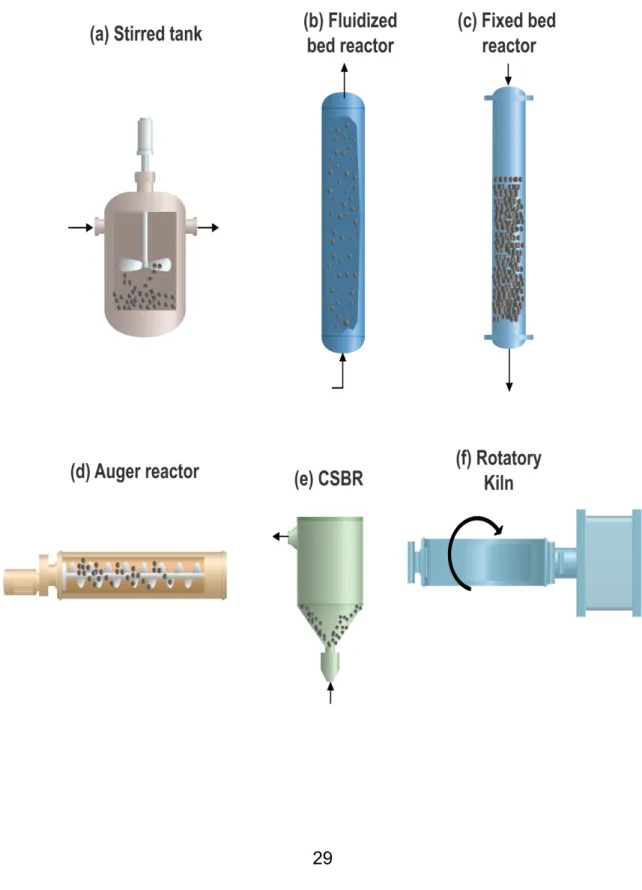
![Table 2. Structure and chemical formula for the main types of heteropolyacids taken from Viswanathan [47] and modified by the author](https://thumb-eu.123doks.com/thumbv2/123doknet/3683537.109177/31.892.251.730.229.417/table-structure-chemical-formula-heteropolyacids-viswanathan-modified-author.webp)
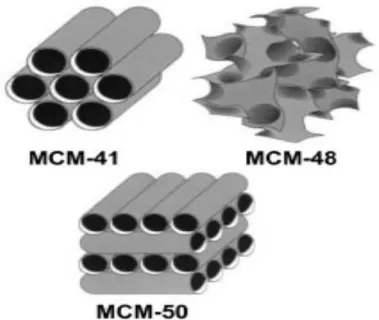
Documents relatifs
Abstract : Zinc oxide (ZnO) thin film and nanostructures have great potential for applications in the fields of optoelec-tronic, sensor devices and solar cells (photovoltaic).. In
As the oxygen concentration is decreased from 21 % to a value near the extinction limit of the fire, the fuel mass loss rate decreases by a factor of about 2.5 from 21 g.. The
This text is based on notes (taken by R. Thangadurai) of three courses given at Goa University on December 15 and 16, 2014, on Algebraic independence of Periods of Elliptic
Within the parametrized limiters framework provided in this paper, high order finite volume and finite difference scheme with successively defined MPP limiters for the multi-stage
cylinder, plate cylinder with the form fixed to its surface and the offset cylinders are equal; the axial stroke value of the oscillator cylinder can be set arbitrarily; no-slip at
To show the potential of such exposure we also introduce three different prototypes that exploit this new educational resource: (1) the OU expert search system, a tool focused
The objective of this study is to experimentally measure adhesion strength between ice and concrete with various applied pressure and contact duration time under constant
Monomethoxy poly(ethylene oxide) (Mn = 2000 g/mol) was first end-capped by the RAFT agent, by esterification of the hydroxyl end-group with the carboxylic acid function of


